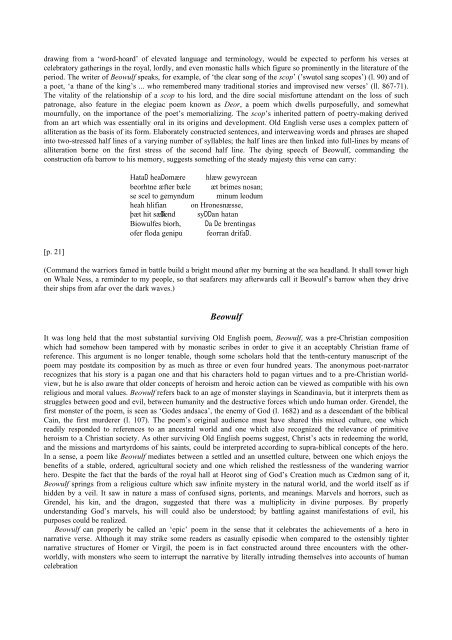THE SHORT OXFORD HISTORY OF ENGLISH LITERATURE
THE SHORT OXFORD HISTORY OF ENGLISH LITERATURE
THE SHORT OXFORD HISTORY OF ENGLISH LITERATURE
Create successful ePaper yourself
Turn your PDF publications into a flip-book with our unique Google optimized e-Paper software.
drawing from a ‘word-hoard’ of elevated language and terminology, would be expected to perform his verses at<br />
celebratory gatherings in the royal, lordly, and even monastic halls which figure so prominently in the literature of the<br />
period. The writer of Beowulf speaks, for example, of ‘the clear song of the scop’ (’swutol sang scopes’) (l. 90) and of<br />
a poet, ‘a thane of the king’s ... who remembered many traditional stories and improvised new verses’ (ll. 867-71).<br />
The vitality of the relationship of a scop to his lord, and the dire social misfortune attendant on the loss of such<br />
patronage, also feature in the elegiac poem known as Deor, a poem which dwells purposefully, and somewhat<br />
mournfully, on the importance of the poet’s memorializing. The scop’s inherited pattern of poetry-making derived<br />
from an art which was essentially oral in its origins and development. Old English verse uses a complex pattern of<br />
alliteration as the basis of its form. Elaborately constructed sentences, and interweaving words and phrases are shaped<br />
into two-stressed half lines of a varying number of syllables; the half lines are then linked into full-lines by means of<br />
alliteration borne on the first stress of the second half line. The dying speech of Beowulf, commanding the<br />
construction ofa barrow to his memory, suggests something of the steady majesty this verse can carry:<br />
[p. 21]<br />
HataD heaDomære hlæw gewyrcean<br />
beorhtne æfter bæle æt brimes nosan;<br />
se scel to gemyndum minum leodum<br />
heah hlifian on Hronesnæsse,<br />
þæt hit sæli Dend syDDan hatan<br />
Biowulfes biorh, Da De brentingas<br />
ofer floda genipu feorran drifaD.<br />
(Command the warriors famed in battle build a bright mound after my burning at the sea headland. It shall tower high<br />
on Whale Ness, a reminder to my people, so that seafarers may afterwards call it Beowulf’s barrow when they drive<br />
their ships from afar over the dark waves.)<br />
Beowulf<br />
It was long held that the most substantial surviving Old English poem, Beowulf, was a pre-Christian composition<br />
which had somehow been tampered with by monastic scribes in order to give it an acceptably Christian frame of<br />
reference. This argument is no longer tenable, though some scholars hold that the tenth-century manuscript of the<br />
poem may postdate its composition by as much as three or even four hundred years. The anonymous poet-narrator<br />
recognizes that his story is a pagan one and that his characters hold to pagan virtues and to a pre-Christian worldview,<br />
but he is also aware that older concepts of heroism and heroic action can be viewed as compatible with his own<br />
religious and moral values. Beowulf refers back to an age of monster slayings in Scandinavia, but it interprets them as<br />
struggles between good and evil, between humanity and the destructive forces which undo human order. Grendel, the<br />
first monster of the poem, is seen as ‘Godes andsaca’, the enemy of God (l. 1682) and as a descendant of the biblical<br />
Cain, the first murderer (l. 107). The poem’s original audience must have shared this mixed culture, one which<br />
readily responded to references to an ancestral world and one which also recognized the relevance of primitive<br />
heroism to a Christian society. As other surviving Old English poems suggest, Christ’s acts in redeeming the world,<br />
and the missions and martyrdoms of his saints, could be interpreted according to supra-biblical concepts of the hero.<br />
In a sense, a poem like Beowulf mediates between a settled and an unsettled culture, between one which enjoys the<br />
benefits of a stable, ordered, agricultural society and one which relished the restlessness of the wandering warrior<br />
hero. Despite the fact that the bards of the royal hall at Heorot sing of God’s Creation much as Cædmon sang of it,<br />
Beowulf springs from a religious culture which saw infinite mystery in the natural world, and the world itself as if<br />
hidden by a veil. It saw in nature a mass of confused signs, portents, and meanings. Marvels and horrors, such as<br />
Grendel, his kin, and the dragon, suggested that there was a multiplicity in divine purposes. By properly<br />
understanding God’s marvels, his will could also be understood; by battling against manifestations of evil, his<br />
purposes could be realized.<br />
Beowulf can properly be called an ‘epic’ poem in the sense that it celebrates the achievements of a hero in<br />
narrative verse. Although it may strike some readers as casually episodic when compared to the ostensibly tighter<br />
narrative structures of Homer or Virgil, the poem is in fact constructed around three encounters with the otherworldly,<br />
with monsters who seem to interrupt the narrative by literally intruding themselves into accounts of human<br />
celebration









